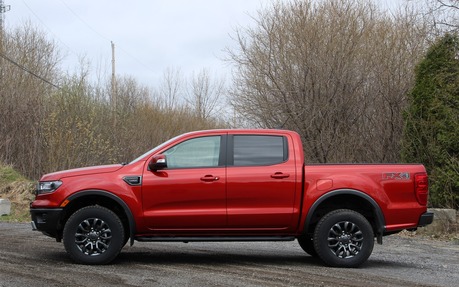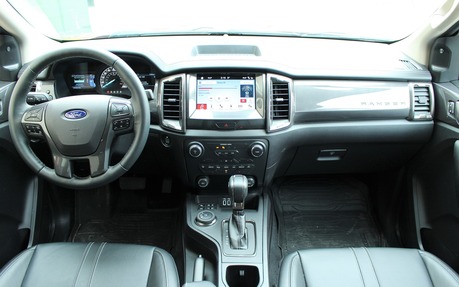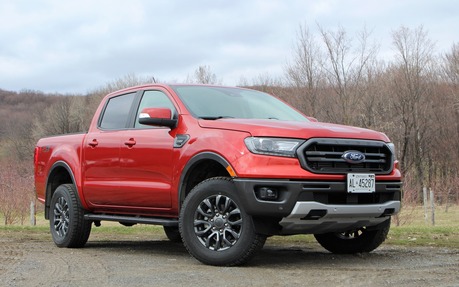2019 Ford Ranger: My, How You Have Changed!
After a seven-year hiatus, the Ford Ranger has returned to the Canadian market. During that time, the small pickup truck changed quite a bit, but it had to if it wanted to compete head-to-head with the competition.
Actually, it’s the first time since the early ‘80s that Ford offers essentially the same Ranger worldwide, and the 2019 model isn’t a clean-sheet design. It was initially coceived by Ford of Australia and hit other markets back in 2011.
- Also: A Ford Bronco Pickup to Rival the Jeep Gladiator?
- Also: Check out the Six Ford Ranger Models for SEMA
Nevertheless, our 2019 Ford Ranger has been adapted for the North American market, and it’s much bigger than the previous generation sold up until 2011. It currently competes with the Chevrolet Colorado, the GMC Canyon, the Honda Ridgeline, the Jeep Gladiator, the Nissan Frontier and the Toyota Tacoma. By the way, a new midsize Ram pickup should be unveiled within the next year.
Given its age, the Ranger looks nothing like its big brother Ford F-150 and bears only a slight resemblance with the brand’s ever-growing line of SUVs. Which isn’t a bad thing, as it gives the pickup a chance to stand out on its own.

While the previous Ranger ended its life as an archaic, budget-minded truck—pricing ranged from about $15,000 to $30,000 back in 2011—this new one starts at $31,069 before freight and delivery charges, and is only available in our country with a four-wheel drivetrain in addition to a choice of extended (SuperCab) or crew cab (SuperCrew) configurations.
If the F-150 offers six engine choices, the Ranger gets only one. It’s a turbocharged, 2.3-litre four-cylinder mill that develops 270 horsepower and 310 pound-feet of torque, meaning it can rival the competition’s V6 engines on paper, in addition to being more fuel-efficient—though only slightly better than the Ridgeline’s V6. During our test, we averaged a very decent 11.0 L/100 km, but we can manage almost the same consumption in an F-150 equipped with the twin-turbo, 2.7-litre V6.
Matched to a 10-speed automatic transmission, the Ranger’s EcoBoost engine doesn’t leave us wanting for power, but it obviously isn’t as smooth as a good naturally aspirated V6, and we’re a little concerned about the long-term durability of force-fed powerplants. For now, let’s just say that we have no reason to believe the one in the Ranger won’t be reliable.
It does allow for a maximum towing capacity of 7,500 pounds or 3,401 kilograms. Only the Gladiator with its gasoline V6 as well as the Colorado/Canyon cousins with their diesel four can pull more, and we’re talking about 7,650 and 7,700 lbs, respectively. The Honda’s 5,000-lb. capacity is laughable in comparison. The Ranger also boasts a class-leading max payload of 748 kg or 1,649 lbs.
Inside, space is adequate up front, but rear-seat occupants might wish for more head- and legroom. The interior design is simple and straightforward, and the only luxury touch is the leatherette upholstery that’s offered in the Lariat trim level. We wish the climate control buttons were bigger or replaced with more convenient rotary dials, though the rest is well laid out.

The available SYNC 3 infotainment system is feature-packed and easy to use—although passengers with long fingernails said they had trouble pressing the main menu buttons on the bottom of the touchscreen. We must choose this system to get Apple CarPlay and Android Auto integration. Also, the optional B&O sound system’s output is fine, but we shouldn’t expect it to be as terrific as a high-end Bang & Olufsen stereo found in German luxury cars.
Thanks to its 225-millimetre ground clearance, its four-wheel drive system with low range and—optionally—the FX4 Off-road package that adds a locking rear differential, skid plates, all-terrain tires and a terrain management system with Normal, Grass/Gravel/Snow, Mud/Ruts and Sand programs, the Ranger can handle itself nicely off the beaten path.
The standard feature list in the base SuperCab XL isn’t all that substantial, so it’s best the move up to the $35,639 XLT that includes blind spot monitoring, lane keep assist, pre-collision warning with autonomous emergency braking and pedestrian detection, cruise control, front and rear park sonar, Ford SYNC and more. The Lariat piles on SYNC 3 with eight-inch touchscreen, LED headlights, ambient lighting, 18-inch alloy wheels, dual-zone climate control, heated front seats and an intelligent key system.
However, the well-equipped Lariat retails for $42,389, and our tester equipped with the FX4 package, the Sport Appearance package, the B&O system, navigation, adaptive cruise control, the tow package and a few other goodies topped the $50K mark.
Now, its rivals can cost as much, but here’s where it gets tricky, and why small pickups almost disappeared from our market a few years ago. We can get a full-size F-150 that’s not only roomier but offers greater capabilities and more power for only a few dollars more a month. Why? Because the automaker offers massive rebates on its bigger pickup. Same issue over at GM.
On the other hand, we get that some buyers want a truck that’s smaller and more manoeuvrable in the shopping mall parking lot. The 2019 Ford Ranger boasts including excellent payload and towing capabilities, but it feels outdated compared to its big brother. It’s less comfortable than the Ridgeline and not nearly as funky as the Gladiator, but definitely has its charm, if we figure that we’ll be spending at least $40,000 on the truck, and not $20K like before.
| Test drive report | |
| Test model | 2019 Ford Ranger |
|---|---|
| Trim level | Lariat 4x4 Super Crew (5.0') |
| Price range | $31,069 – $42,389 |
| Price as tested | 50 089 $ |
| Warranty (basic) | 3 years/60,000 km |
| Warranty (powertrain) | 5 years/100,000 km |
| Fuel economy (city/highway/observed) | 11,8 / 9,8 / 11,0 L/100km |
| Options | N/A |
| Competitive models | Chevrolet Colorado, GMC Canyon, Honda Ridgeline, Nissan Frontier, Toyota Tacoma |
| Strong points |
|
| Weak points |
|
| Editor's rating | |
| Fuel economy | Only the diesel-powered Colorado and Canyon pickups are more fuel efficient than the Ranger. |
| Comfort | The ride’s a little jittery rough roads, rear-seat space could be better. |
| Performance | The 2.3-litre engine does a good job of getting the Ranger up to speed. It just lacks the refinement of a good V6. |
| Infotainment | The SYNC 3 system is easy to use and packed with features, but it’s optional, so Apple CarPlay and Android Auto doesn’t come standard in the Ranger. |
| Driving | The Ranger handles well for a pickup truck, but doesn’t necessarily stand out in its category. |
| Overall | Not the bargain it used to be, but the Ranger compensates with excellent payload and towing capacities, even in base trim. |
